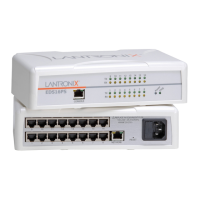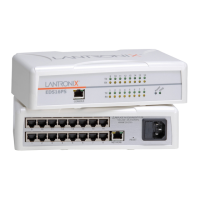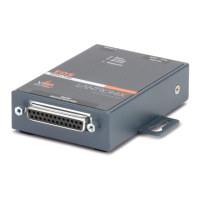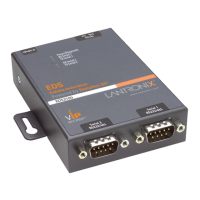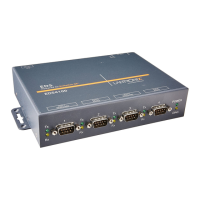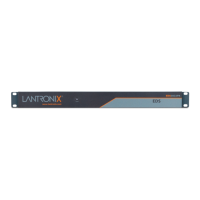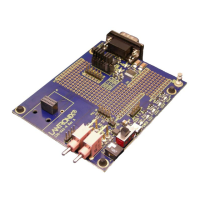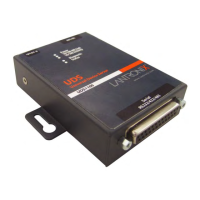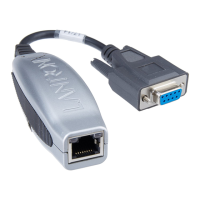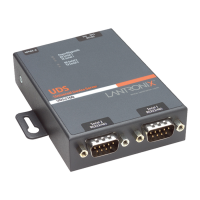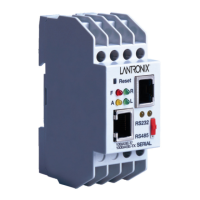Do you have a question about the Lantronix EDS-MD Series and is the answer not in the manual?
Critical safety precautions for operation, environment, and handling.
Risks associated with integrating EDS-MD into IT networks.
Compliance with EMC limits and mitigation measures.
Diagnostic tools for quick problem resolution.
Outlines basic methods for device configuration.
Guidance on finding a location and connecting devices.
Describes serial port count and Ethernet interface details.
Describes system and serial port status LEDs.
Describes Ethernet port status LEDs.
Steps to restore the device to factory defaults.
Technical details for Ethernet, USB ports, and indicators.
Technical specifications for serial ports and lines.
Instructions for mounting on walls needing anchors.
Instructions for mounting on walls not needing anchors.
Steps to locate and access the EDS-MD via DeviceInstaller.
Overview of various settings like Name, IP, Firmware, Status.
Steps to access the Web Manager interface.
The first page displayed after logging into Web Manager.
View and configure Network 1 status and interface parameters.
Configure physical link parameters for Network 1.
Configure network interface settings for Network 2.
Configure physical link parameters for Network 2.
Configure network interface settings for Network 3.
Configure physical link parameters for Network 3.
View and configure serial line statistics and parameters.
Configure tunnel parameters for serial-network communication.
Configure serial settings for tunnels.
Configure how serial data is queued and sent.
Configure how the device listens for incoming connections.
Settings for tunnel accept mode, protocol, and TCP keep-alive.
Configure outgoing connection attempts and security.
Configure remote host address, port, protocol, and keep-alive settings.
Specify conditions for disconnecting connections.
Configure terminal display (CLI or Login Menu).
Configure terminal network interface.
Configure specific terminal lines.
Configure Domain Name System settings and perform lookups.
Configure FTP server for file transfer.
Configure Secure Shell for secure remote access.
Configure Secure Sockets Layer for secure transmission.
Configure device reboot, defaults, firmware, and names.
Reboot the device or restore factory default settings.
Upload new firmware via FTP.
Upload firmware using the device web manager System page.
Update firmware via FTP connection.
Critical safety precautions for operation, environment, and handling.
Risks associated with integrating EDS-MD into IT networks.
Compliance with EMC limits and mitigation measures.
Diagnostic tools for quick problem resolution.
Outlines basic methods for device configuration.
Guidance on finding a location and connecting devices.
Describes serial port count and Ethernet interface details.
Describes system and serial port status LEDs.
Describes Ethernet port status LEDs.
Steps to restore the device to factory defaults.
Technical details for Ethernet, USB ports, and indicators.
Technical specifications for serial ports and lines.
Instructions for mounting on walls needing anchors.
Instructions for mounting on walls not needing anchors.
Steps to locate and access the EDS-MD via DeviceInstaller.
Overview of various settings like Name, IP, Firmware, Status.
Steps to access the Web Manager interface.
The first page displayed after logging into Web Manager.
View and configure Network 1 status and interface parameters.
Configure physical link parameters for Network 1.
Configure network interface settings for Network 2.
Configure physical link parameters for Network 2.
Configure network interface settings for Network 3.
Configure physical link parameters for Network 3.
View and configure serial line statistics and parameters.
Configure tunnel parameters for serial-network communication.
Configure serial settings for tunnels.
Configure how serial data is queued and sent.
Configure how the device listens for incoming connections.
Settings for tunnel accept mode, protocol, and TCP keep-alive.
Configure outgoing connection attempts and security.
Configure remote host address, port, protocol, and keep-alive settings.
Specify conditions for disconnecting connections.
Configure terminal display (CLI or Login Menu).
Configure terminal network interface.
Configure specific terminal lines.
Configure Domain Name System settings and perform lookups.
Configure FTP server for file transfer.
Configure Secure Shell for secure remote access.
Configure Secure Sockets Layer for secure transmission.
Configure device reboot, defaults, firmware, and names.
Reboot the device or restore factory default settings.
Upload new firmware via FTP.
Upload firmware using the device web manager System page.
Update firmware via FTP connection.
| Connectivity | Ethernet |
|---|---|
| Power Supply | 12-48 VDC or 24 VAC |
| Operating Temperature | -40°C to 75°C (-40°F to 167°F) |
| Protocols | TCP/IP, UDP, HTTP, DHCP, Telnet, ARP, ICMP, SNMP |
| Serial Interface | RS-232/422/485 |
| Ethernet Interface | 10/100Base-T |
| Security | SSL/TLS, SSH |
| Power Consumption | 5W (typical) |
| Storage Temperature | -40°C to 85°C (-40°F to 185°F) |
| Humidity | 5% to 95% non-condensing |
| Dimensions | Varies by model |
| Weight | Varies by model |
| Certifications | CE, FCC, UL, cUL, RoHS |
| Type | Managed Ethernet Device Server |
